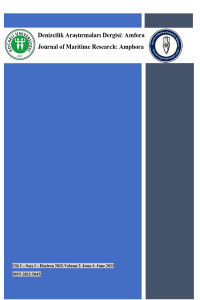Gemi Makinelerinde Egzoz Atık Isısının Geri Kazanımı İçin Bir Termoelektrik Sistemin Sonlu Elemanlar Yöntemiyle Tasarımı ve Analizi
Termoelektrik jeneratör (TEG) literatür taraması sonucu içten yanmalı motorların egzoz sistemlerinden atılan ısının geri kazanımı üzerine geliştirme çalışması yapılmıştır. TEG teknolojisinin kullanımı atık ısının geri kazanılması için çevre dostu bir teknik olarak kabul edilir. Bu doğrultuda incelediğimiz literatürlerde, geçmişte yapılan atık ısı çalışmaları detaylı şekilde incelenmiştir. İçten yanmalı motorlar günümüzde taşıtlarda en yaygın olarak kullanılan tahrik yöntemi olmasına rağmen verimliliklerinin düşük olduğu bilinmektedir. Bu doğrultuda yapılan araştırmalar gösteriyor ki verimliliği %35 olan bir motorun, soğutma suyu ve sürtünme kayıpları yaklaşık %25 oranına sahipken, geri kalan %40’lık enerjinin egzoz gazı ile hiç kullanılmadan atmosfere atıldığı görülmektedir. Dolayısıyla egzoz geri kazanım sistemleri ile enerjiyi dönüştürüp yeniden kullandığımızda bu kayıp enerjinin yüzdesi düşürülmüş olacaktır.
Bu konuda yapılmış çalışmalar incelendiğinde genellikle kara taşıtları üzerinde denemeler yapıldığı ve denizcilik sektöründe örneklerinin olmadığı görülmüştür. Çalışmalar incelendiğinde büyük ebatta termoelektrik jeneratöre rastlanmazken, sıcaklık değerlerinin gemi bacasında da yakalanabileceği görülmüştür. Bu nedenle çalışmaları yakından incelediğimizde sistemin gemilerde de uygulanabilir olacağı düşüncesine varılmıştır. Gemilerdeki egzoz çıkış sıcaklıklarını incelediğimizde ise egzoz manifoldunda 500°C olan sıcaklık, turboşarjer girişte 450°C, turboşarjer çıkışında 300°C ve baca kazanı çıkışında ise yaklaşık 200 °C olduğu görülmüştür. Termoelektrik modülün çalışma sıcaklıklarına en uygun olacak yerin baca kazanı çıkışındaki silencer düzeneği olacağı düşünülmüş ve bununla ilgili detaylı teknik çizimler incelemeye alınmıştır.
Anahtar Kelimeler:
Termoelektrik Enerji, Egzoz Atık Isı, Gemilerde Enerji Verimliliği, Termoelektrik Jeneratör.
Thermoelectric System Design and Optimization for Exhaust Waste Heat Recovery in Marine Engines
Following review of thermoelectric generator (TEG) literature, development study on recovery of heat released from internal combustion engine exhaust systems was conducted. TEG technology is regarded as an environmentally friendly waste heat recovery technique. Waste heat studies conducted in the past have been thoroughly examined in literature we have examined in this direction. Although internal combustion engines are the most commonly used propulsion method in vehicles today, their efficiency is well known. According to research in this area, an engine with a 35% efficiency has approximately 25% of cooling water and friction losses, while the remaining 40% of energy is thrown into the atmosphere with exhaust gas and is never used. As result, when we convert and reuse energy with exhaust recovery systems, we reduce percentage of this lost energy.
When studies on this subject are examined, it is discovered that trials are generally on land vehicles, with no examples in maritime sector. When studies were examined, it was discovered that, while no large thermoelectric generators were encountered, temperature values could also be captured in ship's chimney. As result studies, we concluded that system would also be applicable on ships. The exhaust outlet temperatures on ships are 500°C at exhaust manifold, 450°C at turbocharger inlet, 300°C at turbocharger outlet, and around 200°C at chimney boiler outlet. The silencer device at the exit of chimney boiler was thought to be the best location for thermoelectric module's operating temperatures, so detailed technical drawings were examined.
Keywords:
Thermoelectric Energy, Exhaust Waste Heat, Energy Efficiency in Ships, Thermoelectric Generator,
___
- Antonova, E. E. and Looman, D. C. (2005). Finite Elemets for Termoelectric Device Analysis in ANSYS. Canonsburg: ANSYS Inc.
- Burnete, V.D. et al (2022). Review of thermoelectric generation for internal combustion engine waste heat recovery. Progress in Energy and Combustion Science, 91-142.
- Çengel, Y., Boles M. A. (2012). Termodinamik Mühendislik Yaklaşımıyla. Ankara: Palme Yayınevi.
- Goldsmid, H. J. (2009). Introduction to Thermoelectricity. New York: Springer.
- Gürbüz, H., Akçay, H. and Topalcı, Ü. (2022). Experimental investigation of a novel thermoelectric generator design for exhaust waste heat recovery in a gas-fueled SI engine. Applied Thermal Engineering, 216-231.
- Huang, B. and Shen, ZG. (2022). Performance assessment of annular thermoelectric generators for automobile exhaust waste heat recovery. Energy, 246.
- İslamoğlu, Y. (2018). Termoelektrik Enerji Sistemleri: Güç Üretimi ve Soğutma. Termodinamik Dergisi, 66-70.
- Kraftmakher, Y. (2005). Simple experiments with a thermoelectric module. Eur. J. Phys., 959-967.
- Lan, S., Stobart, R. and Wang, X. (2022). Matching and optimization for a thermoelectric generator applied in an extended-range electric vehicle for waste heat recovery. Applied Energy, 313.
- Luo, D., Sun, Z. and Wang, R. (2022). Performance investigation of a thermoelectric generator system applied in automobile exhaust waste heat recovery. Energy, 238.
- Meng, J. H, Wang, X. D ve Chen, W. H. (2016). Performance investigation and design optimization of a thermoelectric generator applied in automobile exhaust waste heat recovery. Energy Conversion and Management, 71-80.
- Ochieng, AO, Megahed, TF, Ookawara, S. ve Hassan, H. (2022).Comprehensive review in waste heat recovery in different thermal energy-consuming processes using thermoelectric generators for electrical power generation. Process Safety and Environmental Protection, 134-154.
- Sharma, G. et al. (2021). Performance of diesel engine having waste heat recovery system fixed on stainless steel made exhaust gas pipe. Materials Today: Proceedings.
- Smoot, J. (2017, 10 4). Using Peltier modules for thermal management of electronic systems. Electronics Weekly: https://www.electronicsweekly.com/news/using-peltier-modules-thermal-management-electronic-systems-2017-10.
- Solbrekken, R. A. (2008). Comprehensive system-level optimization of thermoelectric devices for electronic cooling applications. IEEE Transactions on Components and Packaging Technologies, 23-31.
- Zaher, M. H, Abdelsalam, M. Y ve Cotton, J. S. (2022). Non-dimensional design optimization of annular thermoelectric generators integrated in waste heat recovery applications. Energy Conversion and Management, 253-266.
- Zhao, Y. et al (2021). Characteristics analysis of an exhaust thermoelectric generator system with heat transfer fluid circulation. Applied Energy, 304-316.
- Başlangıç: 2022
- Yayıncı: Kocaeli Üniversitesi
Sayıdaki Diğer Makaleler
Deniz Yolu Taşımacılığında Freight Forwarder Firmalarının Yaşadığı Sorunlar Üzerine Bir Çalışma
Ali Umut UNAL, Ozan Hikmet ARICAN, Osman ARSLAN
Türk Ticaret Filosunun Gelişimi Üzerine Gemi Cinslerini Temel Alan Regresyon Analizi
Denizcilikte Emniyet Konusu İle İlgili Yapılmış Çalışmaların Bibliyometrik Analizi
